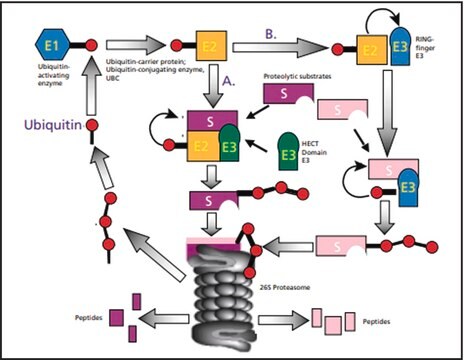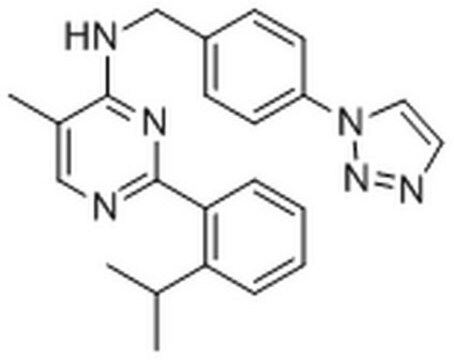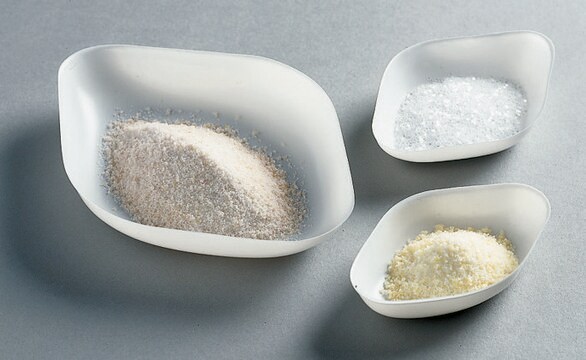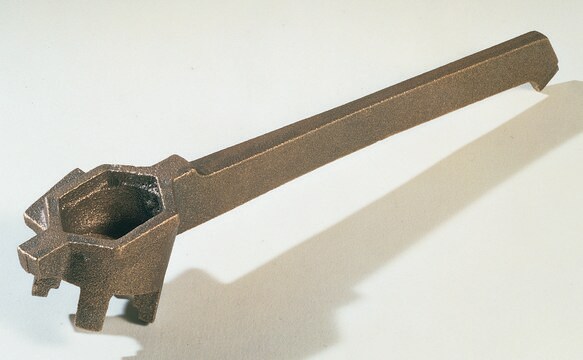17-10388
Di-Ubiquitin (Lys63-linked) Recombinant Protein
Native K63 linked Di-Ubiquitin which can be used as a substrate for proteases that cleave the isopeptide linkage between two ubiquitin molecules.
Autenticatiper visualizzare i prezzi riservati alla tua organizzazione & contrattuali
About This Item
Codice UNSPSC:
12352200
eCl@ss:
32160405
NACRES:
NA.52
Prodotti consigliati
Livello qualitativo
Saggio
>95% (reversed phase HPLC)
PM
Mw ~17 kDa
Produttore/marchio commerciale
Chemicon®
Condizioni di spedizione
dry ice
Descrizione generale
ANTIBODY AVAILABLE!
Anti-Ubiquitin, Lys63-Specific, clone Apu3 (catalogue # 05-1308)
This product is a native K63 linked Di-Ubiquitin which can be used as a substrate for proteases that cleave the isopeptide linkage between two ubiquitin molecules. It can also be used to investigate mechanism of binding and recognition by proteins that contain ubiquitin-associated domains or ubiquitin-interacting motifs (UIMs).
This product is formed by chemical ligation.
Anti-Ubiquitin, Lys63-Specific, clone Apu3 (catalogue # 05-1308)
This product is a native K63 linked Di-Ubiquitin which can be used as a substrate for proteases that cleave the isopeptide linkage between two ubiquitin molecules. It can also be used to investigate mechanism of binding and recognition by proteins that contain ubiquitin-associated domains or ubiquitin-interacting motifs (UIMs).
This product is formed by chemical ligation.
Polyubiquitin chains linked through the Lys48 residue of ubiquitin are most commonly associated with proteins targeted for proteosomal degradation.
In contrast, polyubiquitin chains linked through the Lys63 residue of ubiquitin (Ub) are associated with nonproteolytic functions such as signal transduction. Lys63-linked polyUb chains connect components of NFκB signaling in a highly regulated manner, and genetic evidence indicates the involvement of Lys63-linked Ub chains in stress response and DNA repair. Research in yeast has suggested Lys63-linked Ub chains stimulate endocytosis.
In contrast, polyubiquitin chains linked through the Lys63 residue of ubiquitin (Ub) are associated with nonproteolytic functions such as signal transduction. Lys63-linked polyUb chains connect components of NFκB signaling in a highly regulated manner, and genetic evidence indicates the involvement of Lys63-linked Ub chains in stress response and DNA repair. Research in yeast has suggested Lys63-linked Ub chains stimulate endocytosis.
Applicazioni
LC-MS Analysis
Mobile phase A = 1% CH3CN, 0.1% formic acid in water (MilliQ) and B = 1% water (milliQ) and 0.1% formic acid in
CH3CN. Phenomenex Kinetex C18, (2.1×50 mm, 2.6 μM); flow rate = 0.6 mL/min, runtime = 6 min, column T = 40°C.
Gradient: 5% to 95% B over 3.5 min. (See Figure 2)
Mobile phase A = 1% CH3CN, 0.1% formic acid in water (MilliQ) and B = 1% water (milliQ) and 0.1% formic acid in
CH3CN. Phenomenex Kinetex C18, (2.1×50 mm, 2.6 μM); flow rate = 0.6 mL/min, runtime = 6 min, column T = 40°C.
Gradient: 5% to 95% B over 3.5 min. (See Figure 2)
Componenti
50 µg of Di-Ubiquitin (Lys63-linked) reconstituted in 2.5 µL DMSO and 56 µL of 0.02 M TRIS, 0.25 M NaCl, pH 7.5 to a final concentration of 50 µM.
Qualità
Western Blot Analysis:
0.5-2 μg/mL of anti-Ubiquitin, Lys63-Specific, clone Apu2 (Cat. # 05-1308) detected Lys63-linked Ubiquitin from 1 µg of Di-Ubiquitin (Lys63-linked) Recombinant Protein (Cat. # 17-10388). (See Figure 1)
0.5-2 μg/mL of anti-Ubiquitin, Lys63-Specific, clone Apu2 (Cat. # 05-1308) detected Lys63-linked Ubiquitin from 1 µg of Di-Ubiquitin (Lys63-linked) Recombinant Protein (Cat. # 17-10388). (See Figure 1)
Stoccaggio e stabilità
Store at -80°C. Avoid freeze/thaw cycles.
Note legali
CHEMICON is a registered trademark of Merck KGaA, Darmstadt, Germany
Esclusione di responsabilità
Unless otherwise stated in our catalog or other company documentation accompanying the product(s), our products are intended for research use only and are not to be used for any other purpose, which includes but is not limited to, unauthorized commercial uses, in vitro diagnostic uses, ex vivo or in vivo therapeutic uses or any type of consumption or application to humans or animals.
Codice della classe di stoccaggio
10 - Combustible liquids
Classe di pericolosità dell'acqua (WGK)
WGK 1
Punto d’infiammabilità (°F)
188.6 °F - (refers to pure substance)
Punto d’infiammabilità (°C)
87 °C - (refers to pure substance)
Certificati d'analisi (COA)
Cerca il Certificati d'analisi (COA) digitando il numero di lotto/batch corrispondente. I numeri di lotto o di batch sono stampati sull'etichetta dei prodotti dopo la parola ‘Lotto’ o ‘Batch’.
Possiedi già questo prodotto?
I documenti relativi ai prodotti acquistati recentemente sono disponibili nell’Archivio dei documenti.
Il team dei nostri ricercatori vanta grande esperienza in tutte le aree della ricerca quali Life Science, scienza dei materiali, sintesi chimica, cromatografia, discipline analitiche, ecc..
Contatta l'Assistenza Tecnica.




